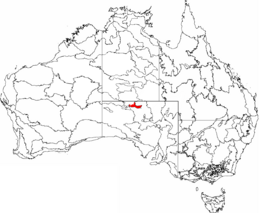Pedirka Desert facts for kids
Quick facts for kids Pedirka Desert |
|
|---|---|

The IBRA regions, with Pedirka Desert in red
|
|
| Area | 1,250 km2 (480 sq mi) |
| Geography | |
| Country | Australia |
| State | South Australia |
| Region | Far North |
The Pedirka Desert is a unique and relatively small desert located in Australia. It's found in South Australia, about 100 kilometres (62 mi) north-west of a town called Oodnadatta. It's also about 250 kilometres (160 mi) north-east of Coober Pedy, which is famous for its opal mines. Just to the north of the Pedirka Desert, you'll find Mount Dare and Witjira National Park.
This desert covers an area of about 1,250 square kilometres (480 sq mi), which makes it one of Australia's smaller deserts. Despite its size, it has some very special features. The sand here is a striking deep-red color. You'll also see many dense woodlands filled with a type of tree called mulga. The sand dunes in the Pedirka Desert are not very tall; they are low, worn down, and spread out, often running parallel to each other.
Contents
Exploring the Pedirka Desert's Environment
The Pedirka Desert is part of a larger natural area known as the Finke bioregion. A bioregion is like a big natural neighborhood. It's an area where the plants, animals, and climate are all quite similar. This helps scientists understand and protect different parts of the environment.
Unique Landscape and Plant Life
The landscape of the Pedirka Desert is truly special. Its deep-red sands are a result of iron minerals in the soil. These sands create a beautiful contrast with the green of the plants. The low, eroded dunes show how the wind and weather have shaped this land over a very long time. They are often spaced far apart and run in straight lines, which is a common feature in many deserts.
One of the most important plants you'll find here is the mulga tree (Acacia aneura). These trees are very tough and can survive in dry conditions. They form dense woodlands across the desert, providing shade and food for animals. Mulga trees are well-adapted to the desert environment, with special leaves that help them save water.
Human Activities in the Desert
Living and working in the Pedirka Desert can be quite challenging. The land isn't ideal for traditional farming, especially for raising large numbers of livestock like cattle or sheep. This is because of the dry conditions and the specific types of plants that grow there.
However, people are finding new ways to interact with and use the land. This might include things like tourism, scientific research, or other activities that are suited to the desert environment. It's important that any development is done carefully to protect this unique natural area.
See Also
- Deserts of Australia
- List of deserts by area

